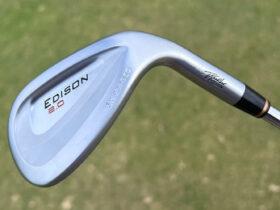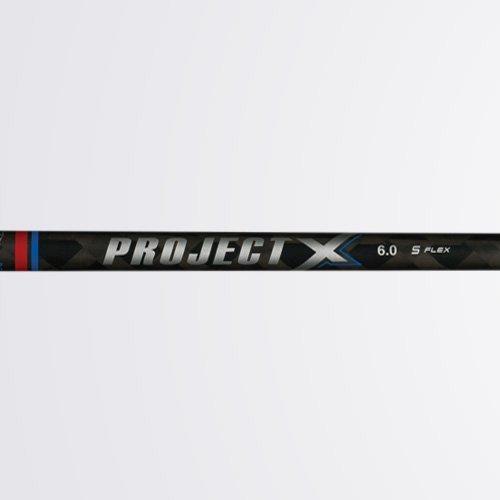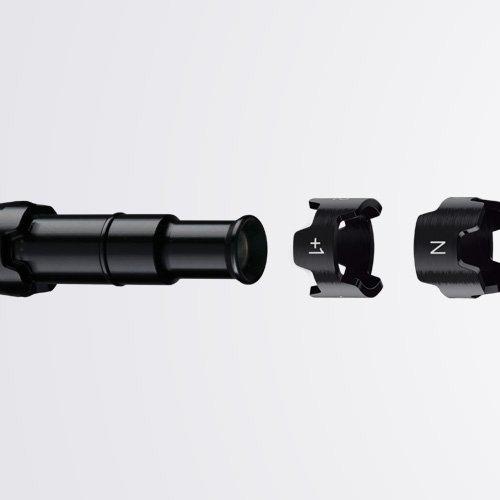Callaway Golf XR Driver Review
When a company brings a slogan like “built for outrageous speed,” the expectations for performance are certainly elevated. With the latest XR Driver release from Callaway, the hype is most certainly palpable. Combining technology like an aerodynamic crown, thinner face, and maximizing shaft load, golfers should go into an XR Driver experience with lofty expectations for higher speeds with solid forgiveness across the face. Being that XR follows a series of “X” drivers worthy of improved speed and better forgiveness, it is only reasonable to expect overall improvement with this ‘race inspired’ look.
Driver Specs and Availability
| Model | Loft | Availability | Length | Lie | CC | Swing Weight |
| 9° | Adjustable | RH / LH | 46″ | Adjustable | 460 | D3 |
| 10.5° | Adjustable | RH / LH | 46″ | Adjustable | 460 | D3 |
| 12° | Adjustable | RH / LH Custom Only | 46″ | Adjustable | 460 | D3 |
| 13.5° | Adjustable | RH / LH Custom Only | 46″ | Adjustable | 460 | D3 |
Shaft: Project X LZ
| Manufacturer | Flex | Shaft Weight | Torque | Kickpoint |
| True Temper | Light | 53 | low-mid | mid |
| True Temper | Regular | 54 | low-mid | mid |
| True Temper | Stiff | 56 | low-mid | high |
Out of the Box
The first thing to catch the eye is the speed step crown. While Callaway is not the first to introduce aerodynamic inspired raised crown elements, they have done so in a way that frames the head well around the golf ball at address. Moving beyond that element, eyes recognize the darker matte finish of the head, which gives off a powerful vibe. During testing, a conversation arose from the matte finish of the crown as it related to a sports car recently seen with a similar paint job. If Callaway’s goal was to give off that ‘race’ inspired look, they certainly seem to have accomplished that feat.
The final eye catching feature of the Callaway XR Driver is the Project X LZ shaft. Designed to show not only the technology built into the shaft, but also donning the shaft characteristics create excellent intrigue for how the pairing of head and shaft will perform together. They are packaged well with the darker grey/black finish with the blue/red/white accents, providing the XR Driver with a very clear perception of new, different, and improved.
From Callaway: Speed From Speed Step Crown – To reduce drag and maximize speed through the swing, we’ve put in a Speed Step Crown and combined it with an optimized aerodynamic head shape. Everything about this driver is optimized for aero efficiency, which is critical to add speed with less drag.
There are impressive videos available with Doctor Alan Hocknell, explaining how the aerodynamics of the head are improved by keeping the air as close to the crown as possible during the down swing. It is hard to believe so much has been considered in this fashion over the last year, however in this iteration of improved aerodynamics, Callaway has done so while keeping the top line improvements of the crown relatively subtle. Despite the bar like design feature of the speed step crown, they were able to incorporate the familiar Chev to indicate ideal ball position.
From Callaway: Speed From R•MOTO Face Technology – This is how we increase ball speeds across the face – by reducing 10% of face weight to make it thinner. R•MOTO leads to more energy efficient energy transfer all over the face, allows us to put the CG 17% lower where most golfers want it, and delivers higher MOI.
Not only did they make the face thinner, they created a sound unique to XR in comparison to many of their other offerings. By taking the weight away from center and driving it into the perimeter, we now have the opportunity to see greater forgiveness and the potential for a ‘hotter’ face. This is the type of driver improvement that has potential to be beneficial for all swing speeds and skill levels.
When the ball makes contact with the center of the face with a neutral face angle, there is a very obvious feeling of the ball being ‘mashed’ by the head. It comes in a combination of sound (which is slightly muted in comparison to less than perfect contact) and the way the ball launches off the face. During testing, it truly became an addiction trying to replicate such an experience, and the results were very telling of high end contact. It seems logical that this can be attributed to the R•MOTO design, creating improved energy transfer.
From Callaway: Speed From Maximum Shaft Load – The shaft is a key component to speed, that’s why XR comes stock with the new Project X LZ. It produces maximum shaft load during the downswing loading zone for greater energy transfer to the ball.
The Project X LZ shaft has been an incredibly interesting experience. While golfers tend to lean towards the expectations of a slightly rigid feel in their ideal shafts, the ‘loading zone’ (the middle section of the LZ) is designed to be softer in flex to help golfers generate maximized shaft load. This can lead to confusion during a demo of the head, assuming the shaft is too ‘whippy’ or plays ‘soft’ to flex, but testing proved that performance was not hindered by this loading sensation.
The technology is built into the shaft, where users can visually see the graphite in a crossing pattern (these are known as FlexLok torsional bands) through the loading zone section. It is built softer to flex in that area and the two designs work together to provide the user with maximum shaft load without the loss of stability, resulting in higher ball speeds with excellent control. During testing, there is a very noticeable loading sensation in the Callaway XR Driver, but it rarely came at the cost of ‘losing the head’ or having the ball fall offline in any major way. For how XR is presented, this seems to be one of the best stock shaft pairings available.
What many golfers will receive with the LZ shaft pairing and the XR Driver head is an ideal mid to mid-laugh ball flight. The head profile compliments the mid kickpoint of the LZ to create a balanced flight that will not be too ‘spinny,’ which is ideal for a large percentage of amateurs.
From Callaway: OptiFit Adjustability – Choose from 8 different loft and lie configurations to find the perfect launch for your ball flight. When you get the right launch conditions, you get more distance.
The OptiFit adapter has been slightly improved from what golfers may be familiar with, removing the plastic tip section that was known to crack in some situations. What remains is a highly functional adapter that allows the golfer to change between lofts and face angle to accommodate their swing preferences. During the XR Driver testing, golfers of various skills and swing types could easily find an ideal setting, and actually introduced the perfect draw for one golfer fighting a fade with his typical gamer.
Sound
With the racing theme of XR, it makes a lot of sense to ‘unleash’ the sound potential of the driver. While some of Callaway’s other offerings produce a more subtle and slightly muted sound, the XR Driver imparts a lively contact sound. Nothing overly loud or obnoxious, however golfers are treated to a very strong, sharp sound on contact. The sound changes slightly as you move around the face, losing some of the sharpness with contact away from the center. During testing, it could be discerned on sound alone where golfers were making contact, and that translated into very beneficial knowledge for the next swing.
Spin and Head Profile
One of the inclinations golfers often have is to try and make sense of the head they are swinging as it relates to what they are familiar with. It is an understandable thing to do, however the profile of the head must be respected in order to properly categorize where it fits in the club spectrum as a whole. Callaway makes note of reduced spin on account of perimeter weighting, and it appears at though they have accomplished exactly that as it relates to the former “X” series heads. The Callaway XR Driver seems to sit right in the middle of the spin spectrum, with a lighter weight profile that allows golfers to take faster strikes at the golf ball.
Forgiveness
While the advertisements on Callaway’s website focus on ball speed and loading, the XR Driver looks to be taking on a strong forgiveness profile. Of course it will always be most ideal to make contact on the center of the head; however, impressive results for a wide range of golfers were experienced when the ball contact traveled around the face of the XR Driver. During testing, sound was more telling on weaker contact than ball flight was. This is something that most golfers should probably seek in their driver performance.
There was some ball speed and distance loss experienced on weaker strikes, however unless the ball was trapped by a block pull or push, the fade or draw flight patterns were only mildly magnified by slightly weaker strikes. This presents the XR Driver to be optimal for golfers who aren’t hitting the center of the face all the time, and could use some help with potential lateral misses. Fairways on less-than-perfect strikes were common during the XR Driver testing.
Parting Thoughts
Callaway proves with the XR Driver that performance can be achieved and optimized in a lighter package that enhances swing speed and ball speed. They have picked an excellent shaft to complement their idea of ‘outrageous’ speed, incorporating “loading zone” technology to give golfers the best opportunity to build speed into contact. For those pursuing a lighter, non-tour profile and seeking quality forgiveness and sound, the XR Driver should be atop their list of demo options. For more information on the Callaway XR, visit www.CallawayGolf.com.






















Nice job Dan. I can’t wait to get mine on course and see what I can come up with. I always felt like something was just off with the Bertha for me and I have a feeling this is going to be right in my wheelhouse. The sound really is awesome and it’s the nicest looking head I have seen. Pictures don’t do it justice.
Very nice review Dan. Lots of solid information and detailed aspects of what makes the club perform.
I’m still in the demo and evaluate mode with this one.
Well done Dan. I’m excited to put some swings on this one. A lot of positive thoughts swirling on this head and shaft pairing.
Nice write up Dan! You definitely covered all the highlights of the driver, (and there are a lot)
Great write up. Really captures the entire XR package here.
Excellent stuff Danathan. You hit on all the points IMO, its acoustically a departure for Cally to me, but its again a really solid club.
Good review Dan. Some real god info and insights.
Just read through your review again Dan and I am thinking I really do need to go demo this driver. It may be just what I need to help me out with a little more distance. Good job buddy.
Dan your review was Complete,I thank you for Your Input.I just received one of these X-R Drivers,with a Senior Shaft.I took about 15 Practice Swings before I decided on this Particular Club.I noticed How Fast my Swing Speed Increased with a Few Swings,the Speed on the Swing Monitor jumped about 10 mph in a matter of No Time.I am so Excited to give a Full Try Out Today,went a play a Full 18,my confidence is Rising and I know the results will justify my Choice.
I have an X2 Hot Driver which is 13.5″. I am 83 with a high handicap. Should I change the +1 to a -1 because it is a 13.5 rather than a 9.5? I also changed it to a D because I do splice some drives.
I am using this driver for the first time. Your help is appreciated.
Thanks!
Ralph